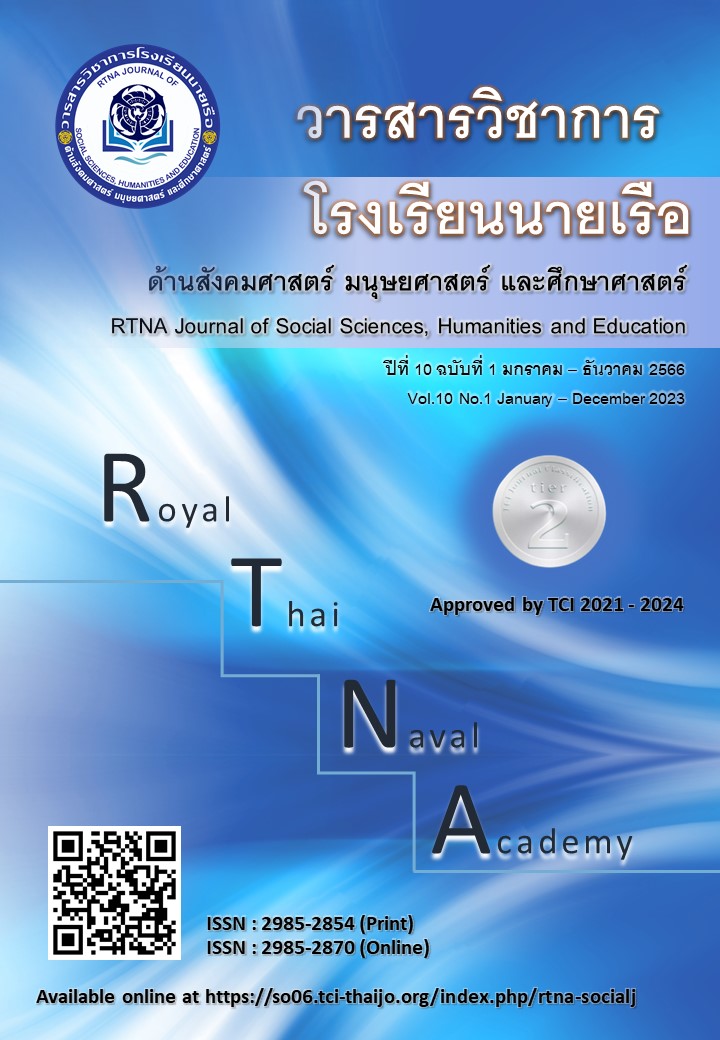Development of Afshan Mathematics Anxiety Scale (Afmas) for Students in elementary school under the Secondary Educational Service Area Office Sukhothai
Keywords:
Mathematics Anxiety, Scale, Elementary SchoolAbstract
The objectives of this research were 1) to examine the precise and accuracy of the Mathematics Anxiety Scale of Afshan et al. (2022), and 2) to study the math anxiety of students, all genders, various between grade 7-9. The study groups were 412 students from elementary school under the Secondary Educational Service Area Office Sukhothai
The research instrument was Afshan Mathematics Anxiety Scale: Afmas by Afshan et al. (2022), Thai edition. There two sections for studying. The first section dealt with general information about respondents, and the second dealt with mathematics anxiety scale. The mathematics anxiety scale included 24 statements with 5-rating scale levels. The statements addressed four elements, including Mathematics Lesson Anxiety, Mathematics Performance Anxiety, Mathematics Assessment Strategies Anxiety, and Mathematics Anxiety scale. The Cronbach’s alpha coefficient was applied to analyze data. The second order confirmatory factor analysis was analyzed. The results showed that 1) the validity of the Afshan Mathematics Anxiety Scale was high at .947 and the precise and accuracy of the model was reliable, and 2) at different grade levels had no difference in mathematics anxiety. Regarding gender, female students were anxiety about mathematics more than male students. Class and gender had no interaction effect on mathematics anxiety.
References
กระทรวงศึกษาธิการ. (2551). หลักสูตรแกรกลางการศึกษาขั้นพื้นฐาน พุทธศักราช 2551. สืบค้นจาก http://academic.obec.go.th/images/document/1559878925_d_1.pdf
ณัฐณิชา เถาว์โท. (2563). การเปรียบเทียบการแก้ปัญหาทางคณิตศาสตร์องนักเรียนชั้นมัธยมศึกษาปีที่ 1 ที่มีความวิตกกังวลทางคณิตศาสตร์และการรับรู้ความสามารถของตนเองที่แตกต่างกัน (วิทยานิพนธ์ปริญญารุศาสตรมหาบัณฑิต). มหาสารคาม: มหาวิทยาลัยราชภัฏมหาสารคาม.
ประสพชัย พสุนนท์. (2558). ความเที่ยงตรงของแบบสอบถามสำหรับงานวิจัยทางสังคมศาสตร์. วารสารสังคมศาสตร์ มหาวิทยาลัยศรีนครินทรวิโรฒ, 18(18), 375-396.
ไพศาล วรคำ. (2555). การวิจัยทางการศึกษา. (พิมพ์ครั้งที่ 5). มหาสารคาม: ตักสิลาการพิมพ์.
มณีรัศมิ์ พัฒนสมบัติสุข. (2564). การตรวจสอบคุณภาพเครื่องมือวิจัยทางการพยาบาลและสังคมศาสตร์. วารสารเครือข่ายวิทยาลัยพยาบาลและการสาธารณสุขภาคใต้, 8(2), 329-343.
วราพร เอราวรรณ์. (2564). การวิเคราะห์ข้อมูลการวิจัยทางการศึกษาด้วยโปรแกรม Mplus. กรุงเทพฯ: สำนักพิมพ์จุฬาลงกรณ์มหาวิทยาลัย.
วิกิพีเดีย. (2562). อาการกลัวคณิตศาสตร์. สืบค้นจาก https://th.wikipedia.org/wiki/อาการกลัวคณิตศาสตร์.
สุทิศา ตันติกุลวิจิตร, เสรี ชัดแช้ม, ภัทรวดี มากมี และศราวิน เทพสถิตภรณ์. (2562). ผลของความแตกต่างระหว่างเพศและบุคลิกภาพที่มีต่อรูปภาพ และเสียงดิจิตอลที่เร้าอารมณ์ด้านการตื่นตัวในผู้ใหญ่ตอนต้น : การศึกษาคลื่นไฟฟ้าสมองสัมพันธ์กับเหตุการณ์. วารสารคณะพยาบาลศาสตร์, 27(3), 64-78.
Afshan, N., Rizwan, A. R., Irfan, B., Khateeb, A. K., Abdul, G. & Abdul, M. (2022). Development And Validation Of Afshan Mathematics Anxiety Scale (Afmas). Webology, 19(3),1991-2011.
Bradley, M.M., & Lang, P.J. (2007). The International Affective Digitized Sounds (IADS-2): Affective ratings of sounds and instruction manual. Tech. Rep. B-3. University of Florida: Gainesville, Florida.
DeVellis, R. F. (2017). Scale Development: Theory and Applications. (4th ed.). Thousand Oaks, CA: SAGE.
Ding, L., Velicer, W.F., & Harlow, L.L. (1995). Effects of estimation methods, number indicators per factor, and improper solutions on structural equation modeling fit indices. Structural Equation Modeling. 2, 119 - 144.
Fennema, E. & Sherman, J.A. (1976). Fennema-Sherman mathematics attitudes scales: Instruments designed to measure attitudes towards toward the learning of mathematics by females and males. Journal for Research in Mathematics Education, 7(5), 324–326.
Hair, J. F., Black, W. C., Babin, B. J., & Anderson, R.E. (2019). Multivariate Data Analysis. (8th ed.). Andover, Hampshire: Cengage.
Hembree, R. (1990). The nature, effects, and relief of mathematics anxiety. Journal for Research in Mathematics Education, 21, 33–46, doi:10.2307/749455
Kline, P. (1999). The handbook of psychological testing. 2nd ed. London: Routledge.
Plake, B. S., & Parker, C. S. (1982). The development and validation of a revised version of the Mathematics Anxiety Rating Scale. Educational and Psychological Measurement, 42(2), 551-557. https://doi.org/10.1177/001316448204200218
Richardson, F. C., & Suinn, R. M. (1972). The Math Anxiety Rating Scale: Psychometric data. Journal of Counseling Psychology, 19(6), 551–554. https://doi.org/10.1037/h0033456
Sandman, R. S. (1980). The mathematics attitude inventory: Instrument and user's manual. Journal for Research in Mathematics Education, 11(2), 148–149.
Tabachnick, B. G., & Fidell, L. S. (2007). Using Multivariate Statistics. (4th ed.). New York: Pearson.
Downloads
Published
Issue
Section
License
Copyright (c) 2023 Royal Thai Naval Academy

This work is licensed under a Creative Commons Attribution-NonCommercial-NoDerivatives 4.0 International License.
The author has the sole responsibility for the material published in RTNA Journal of Social Sciences, Humanities, and Education, which the editorial team may not agree on that material.
RTNA Journal of Social Sciences, Humanities, and Education owns the copyright of the text, the illustration, or other material published in the journal. No parts or the whole of the material published may be disseminated or used in any form without first obtaining written permission from the academy.






